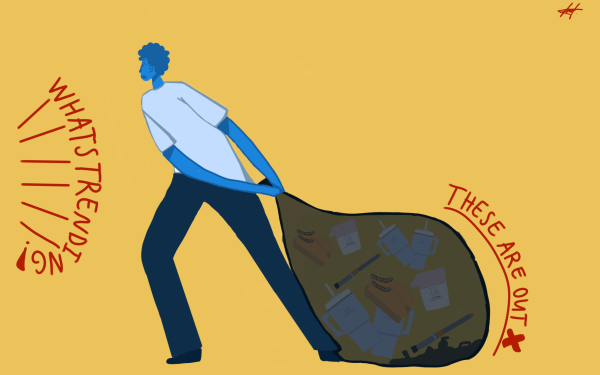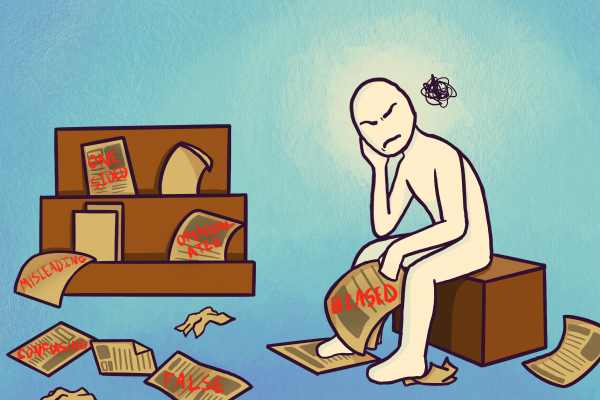[Opinion] Unnecessary holiday consumerism has a multitude of negative implications
Consumerism around the holiday’s often cause several negative and unnecessary implications.
December 15, 2021
On the Friday after Thanksgiving, Americans ring in the holiday season by doing close to anything to gain access to the hottest Black Friday sales. Enticed by the influence of clever advertisements and the promises of once-in-a-lifetime savings, hundreds of shoppers camp outside of retail stores for hours on end, all in an attempt to get a head-start on their holiday shopping.
Inside, it looks like the aftermath of a zombie apocalypse; Clothing racks are ravaged, items are strewn all over the floor and products are out of place, as customers try to cash in on the “door-busting deals.” There is an occasional altercation when two customers try to claim the last available blender or the marked down laptop—but it’s all in the name of Christmas spirit, right?
While in the past the holidays were defined as a period for expressing gratitude and spending quality time with family, they are now characterized by materialism.
Consumerism is defined as society’s fixation on the purchasing of consumer goods. Unfortunately, this means that for many individuals, both their wellbeing and happiness depend significantly on consumption. The celebration of holidays has undoubtedly undergone the influence of consumerism, changing the festivities from a chance to pause from commercial activities to a major engine for our economy.
Currently, there are 11 annual United States federal holidays including Christmas, Thanksgiving and Independence Day. In addition, numerous non-federal holidays, such as Valentine’s Day and Mother’s Day, have been promoted in order to boost the economy even more.
Furthermore, “non-holiday holidays” such as Black Friday, Cyber Monday and Small Business Saturday seem to have the sole task of stimulating purchases by exploiting the attractiveness of sales.
However, no matter the holiday, it seems like in recent years they have all just become a money grab. Take Hanukkah for example, a holiday celebrated in the Jewish religion, and a shining example of how the true meaning of the holidays have been misconstrued by the effects of consumerism. The holiday originated as a way to celebrate the rededication of the Second Temple of Jerusalem and is observed by lighting candles on each of its eight nights.
In the late 19th and early 20th centuries, oppressive treatment towards the Jews in Europe convinced many to emigrate to the United States. Upon arrival, Jews felt pressured to assimilate with American culture in order to avoid ostracization. At the time, Christmas had already been recognized as America’s season for gift giving. In an attempt to follow the trend, Jewish-Americans implemented consumerism as part of the Hanukkah tradition. Time for religious observance quickly became replaced with time spent shopping for gifts, and the meaning of Hanukkah became diluted with materialism.
Still today, very observant Jewish families, as well as most families living in the State of Israel, do not participate in gift-giving during Hanukkah. Instead, they devote the eight days to spending quality time with friends and family.
Another example is Christmas, which arose from humble, religious origins. Now it has been commercialized to the point where the only thing people care about are the gifts under the tree.
Each year it seems Christmas comes quicker than ever before, with decorations often going up as soon as the day after Halloween. This mad dash to the Christmas finish line encourages consumers to begin their holiday shopping as soon as possible, with some brands starting their advertisement campaigns well before the December holiday. These campaigns provide various eye-catching sales, deals and coupons in an attempt to cash in on consumers’ fears of missing out.
This intense and targeted marketing has resulted in consumers losing the core values of the holiday seasons. It has also dictated the way families spend the festive period and how much time they dedicate to the purely religious celebration of some events.
An additional marketing tactic companies utilize is to tack real values like love and family onto cheap products, promising happiness to the person receiving them. Retailers exploit the idea of family by constantly repeating the traditional holiday messages of being joyful with family and friends as a strategy for economic gain.
According to the marketing agency Branded3, a study conducted on social media users on Twitter and Facebook showed that 46.2 percent of consumers reported feeling joy towards Christmas ads while 52.6 percent experienced anger and sadness. Scrolling through social media during the holiday season should not be an upsetting experience to the point where a majority of users are distressed.
Consumerism does not just affect the consumer however. The toll that overconsumption has and will continue to take on our environment are significant and ever-lasting. According to the United States Environmental Protection Agency, Americans produce 25 percent more waste than usual between Thanksgiving and New Year’s Day.
With COVID-19 still prevailing, this number is expected to rise dramatically as online shopping becomes the preferred gifting method, accumulating more waste in the form of packaging materials.
Moreover, despite the obvious convenience of online shopping from sites such as Amazon and Walmart, shopping in-person is better for the environment as it does not require packaging materials and transportation pollution. Many people buy items online frequently, but only buy a few at a time, resulting in more packaging and pollution.
The effects of sending this excess waste to sit in landfills include contributing to the pollutants that corrupt the elements essential to human life: air, land and water. Buying material products also supports an institution which depletes our natural resources for our own benefit.
Trees mostly fall victim to this, as they are needed for items like wood and paper. Around the holidays, shopping bags, ribbons and packaging like wrapping paper contribute an additional million tons of landfill waste per week, accounting for an inconceivable amount of trees.
Many people see the holidays as an opportunity to update their wardrobe. However, they often fail to realize the consequences of this mentality. About 1,800 gallons of water are needed to grow enough cotton to produce a single pair of classic blue jeans. If you are looking to purchase a fashionable cotton shirt to match, that would add around 400 gallons to your total.
According to Professor Benjamin Sovacool at Aarhus University in Denmark in an article published on “The World Counts”, “There will be no water by 2040 if we keep doing what we’re doing today,” as consumerism requests more water than the Earth can provide.
According to a 2019 article by the World Bank, the fashion industry alone accounts for 10 percent of annual global carbon emissions in Earth’s atmosphere. This is greater than that of international flights and shipping, totaling to around 1.7 billion tons of carbon. The fashion industry is a fundamental contributor to the increase in global warming and, ultimately, climate change.
Consumption of fashion during the holidays makes this already detrimental occurrence astronomically worse. The National Retail Federation has said that it expects “holiday sales during November and December to rise between 8.5 percent and 10.5 percent, for a total of between $843.4 billion and $859 billion of sales.”
As the holiday season means buying gifts for parents, sisters, brothers, friends and everyone in between, we often look for cheaper avenues. Too often, this leads to participating in what is known as fast fashion.
Fast fashion refers to cheap and trendy clothing that is mass-produced at low costs, usually due to the exploitation of workers. To achieve inexpensive production, fast fashion workers are forced to endure inhumane working conditions in sweatshops, where some even work for more than 100 hours per week with outstandingly low wages.
Fast fashion companies have also been known to rely heavily on child labor due to the outsourcing of workers to foreign countries, like Bangladesh, where these conditions are normalized. Not only is this immoral, but it also exposes children to extremely dangerous working conditions. According to the United Nations International Children’s Emergency Fund, 170 million children are employed in the garment industry alone.
Excessive gift giving forces these negative labor practices to persist and expand in order to stock the shelves in the time for the holiday rush.
Starting in the 19th century as a way to show class and sophistication, the tradition of gift-giving has carried on to present day celebrations. In the United States alone, over $200 billion are spent on the seven major holidays each year.
The basic essence of gift-giving revolves around showing our love, respect and appreciation for the people that we care about.
As the world normalizes consumerism more and more each day, people aim to keep up with the trends of society, purchasing more as well. This is especially applicable to younger generations who want to own the newest technology, toys and clothing. Unfortunately, parents who fear letting their children down sometimes end up splurging on holiday gifts and spending beyond their means.
This pressure stems from a society of people who ridicule others based on what they can or cannot afford. Low-income parents fear that their children will face embarrassment at school if they do not arrive in the newest pair of sneakers or the latest and greatest iPhone. Watching wealthier peers list off their shiny new holiday gifts weighs on children emotionally and can greatly impact their self-esteem.
This not only places a huge financial strain on parents, but also an emotional one. In order to provide for their kids’ wants, impoverished parents will often put their own wellbeing on the backburner. This risks parents’ mental and physical health alike. Although not uncommon, what we often do not speak about is the parents that skip meals or even doctor’s visits throughout the year in order to save up enough money for holiday gifts.
While there is nothing wrong with buying gifts for those that we love, gift-giving has morphed into a yearly obligation that is focused less about the person receiving the supposedly meaningful gift and more about a sense of necessity. Despite people claiming “let’s not do gifts this year,” people often feel compelled to buy gifts for their loved ones, even if it is unnecessary, badly made or environmentally disastrous.
However, there are still a multitude of ways to give gifts throughout the holiday season while still limiting your consumption and protecting the environment.
One option is buying second-hand or locally sourced gifts that often not only support small businesses, but are also a more economic-friendly option. They are not being produced by large corporations, therefore the products have less of a carbon footprint. Both thrift and consignment stores are a good place to start when looking for a wide variety of second-hand gifts such as clothes, books and games.
Additionally, focus on buying practical items that people can immediately use and benefit from in their daily life, rather than impracticable flashy items. Some beneficial gifts examples are skincare products, towels and watches.
Another option to consider is gifting experiences instead of items. Instead of a material good that has crossed the sea, opt for a local massage, performance or hike. These experiences not only create fun times and guaranteed memories, but they also boost the local economy, allowing the experience provider to benefit as much as the gift recipient.
Making your own gift is an additional way to combat overconsumption. Arts and crafts projects such as homemade bracelets or pottery can have more sentimental value than a store bought gift. Even something as simple as a colored card can have great value.
Consumerism is not only related to the purchase of gifts, but also of food. For many of us, food is the highlight of our holiday traditions and memories. Certain holidays are synonymous with specific meals such as turkey on Thanksgiving and chocolate on Valentine’s Day.
Worse off, food is a large carbon emitter, specifically meat and dairy which are prominent during the holiday season. All the food that we do not eat is turned into waste which is another problem for the planet.
This wasted food also wastes money, time, labor, transportation, water and land used in food production. Aside from this waste, food decomposes without oxygen in landfills releasing methane gas, a leading driver of global climate change that is up to 86 times more potent in trapping heat than carbon dioxide according to a 2015 article by the Scientific American.
Not only is that waste hard on your wallet and our environment, but it’s downright shameful when 40 million Americans struggle with hunger according to the U.S. Department of Agriculture.
The easiest way to reduce food waste during the holidays is to buy and prepare the right amount of food in the first place. Creating a detailed shopping list is necessary in limiting food waste and preventing getting sucked in by appealing holiday sales throughout the store. These sales can cause excessive purchases that may not be needed and may not actually be eaten.
Another way to be conscious about food waste throughout the holiday season is by saving leftovers in the freezer for future meals. Donating extra unused items to food banks and soup kitchens is another ethical way to combat waste.
Sustainability is all about making sure that the decisions we make today — no matter how insignificant they seem now — do not negatively impact the ability of future generations to live prosperously.
Being generous is moralistic, but today we are so concerned with quick and easy consumption that we rarely understand the many unintended consequences a gift could have. The majority of the products we buy are made with very little consideration of their future impacts and are just momentary items, quickly destined for the garbage.
Starting to make change is easy. In the future, we should take a step back from the world of targeted advertising and spend time offline. Appreciate the presence of family and friends, bake goods for neighbors or volunteer at a soup kitchen. Instead enjoy the holiday season for what it is: a time to be together with loved ones, free from the stress of giving and getting material goods.

























